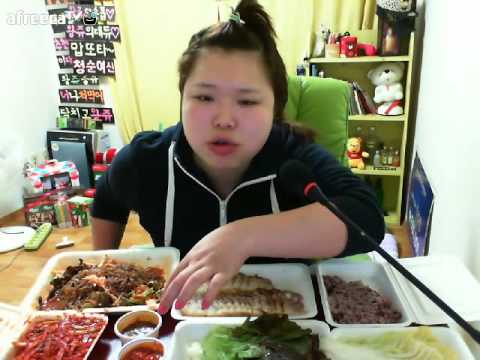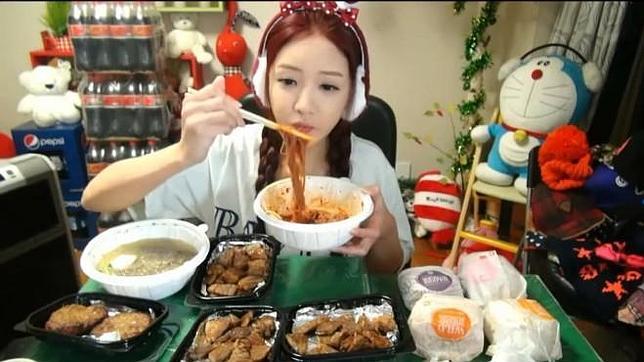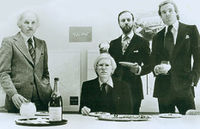Scale & Platform: Difference between revisions
No edit summary |
|||
| Line 44: | Line 44: | ||
[https://www.youtube.com/watch?v=mfHkCXGXs9I Bento lunchbox description 2] | [https://www.youtube.com/watch?v=mfHkCXGXs9I Bento lunchbox description 2] | ||
== Damukare == | |||
Japanese Curry Rice dish which is presented in the form of a dam. The dam is made of rice and prevents the curry to fload the space at the other side of the dam. | |||
== Mukbang: Nr. 39 == | == Mukbang: Nr. 39 == | ||
Revision as of 11:23, 23 June 2015
Mukbang
Muk-bang or mukbang (Korean: 먹방, lit. "eating broadcast") is a type of performance in which someone eats large quantities of food, while interacting with their audience, for apparent entertainment value. Usually done through a webcast, muk-bang became popular in South Korea in the late 2000s. - according to Wikipedia. Mukbang is sometimes called Foodporn, or Food-Selfie. The person who is performing eating the food is called a Broadcast Jockey (BJ). Mukbang slowly becomes popular in countries outside Korea.
When you watch a Mukbang video you see a person (mostly little Korean girls) unpacking and eating the food. This can take for hours sometimes. Meanwhile the person explains what she is eating and how she likes it. At the sometime the person is in contact with an audience. Through a lifestream the audience can ask questions and talk to the person who is eating. There are several hypotheses why Mukbang is popular. One could is the rise of one-person households in Korea and by watching people eat it looks like you are eating (or at least socializing) with someone else. Some say it helps against being lonely. The market of Mukbang is huge. There are millions of people involved into it. Either by being a BJ or as a watcher. And Korea seems the place to be where this market is originated. It has a strong internet network and a high density of people owning a mobile.
BJ's earn there money by donations of viewers send during the broadcast. These come in the form of virtual gifts known as star balloons with each one worths 10 US cents. All BJ's are connected to Afreeca TV.
Characteristics of a Mukbang Video:
A Mukbang video is usually made frrom a frontal point of view. This can be a webcam but mostly it is done by a camera on tripod. This camera is connected to a livestream and audience can watch and interact with the Broadcast Jockey (BJ). In the video you mostly see a BJ surrounding by many plates of food. In the video the BJ explains what the food is, slowly eats and interacts with the audience. Mostly the food is local street food from restaurants, but sometimes the food is made by the BJ itself (there are some trained chefs who became BJ).
Some Mukbang broadcasters are:
- Joon Ha Park (BJ-Sof)
- Ji Hwan Choi (BJ-Biryong)
- Ji Hyun Kwon (BJ-Wang Joo)
- Hanna Choi (BJ-Hanna)
Examples:
BJ-SOF
BJ-Biryong
BJ-Wang Joo
BJ-Hanna
BJ-Hanna
Documentary by Vice: The food porn stars of South Korea
Bento Lunchbox
Bento is a single-portion takeout or home-packed meal common in Japanese cuisine. A traditional bento holds rice, fish or meat, with pickled or cooked vegetables, usually in a box-shaped container. Containers range from disposable mass produced to hand crafted lacquerware. Bentos are readily available in many places throughout Japan, including convenience stores, bento shops, railway stations, and department stores. - source Wikipedia
Damukare
Japanese Curry Rice dish which is presented in the form of a dam. The dam is made of rice and prevents the curry to fload the space at the other side of the dam.
Mukbang: Nr. 39
I want to extend my project Nr. 39 by integrating Mukbang. I want to shoot videos of me while eating the Nr. 39-dish. There are 2 options:
- Shoot video in the restaurant
- Shoot video in a created environment (studio).
Concerns shooting in restaurant:
I'm I allowed to shoot in a restaurant? And if so, in which extend do I have freedom to do what I want? What to do with other people in the restaurants? Do I disturb them? Can I use them in my videos as extras?
I can ask permission to do so, but the actually shooting needs preparation. Second, how do I act myself when there is a camera on me, while eating a dish alone in a restaurant? How do I deal with events that might occur out of my pre-thought script?
Concerns shooting in studio:
A solution to have more control, more confidence is to do a Mukbang-video in ste studio. By doing that I can create my own environment and prepare myself mentally better for the performance, there is more control. The problem with a studio setting is how to get the food there? Second an important element of my project Nr. 39 is a photo of a dish prepared and composited by the restaurants chef and taken in that restaurant. By for example bringing the food (take away) to the studio I miss the element of composition by the chef and the table-decoration of the restaurant.
To order a Nr. 39 and let it bring to the studio by a courier can be interesting. To courier can put the food on the table and by doing so is part of the video, but the money transaction is something I would like to keep outside the video. Concern: What if there is no option for a courier? How to control the courier? How to make him part of the video? Can the courier be fake?
Technical plan:
Script:
Script: for eating Nr. 39 in restaurant:
- Start filming when seated
- Waitress brings menu and ask for drink
- Order drink
- Look into menu and order the Nr. 39-dish
- Wait for dish to come, prepare for shooting (make space for shooting, prepare phone)
- When arrived, make photo
- Eat Nr. 39-dish
- When finished, ask for bill
- Pay and leave the restaurant
Script: for ordering Nr. 39 and ask courier to bring:
- Start filming(?)
- Order Nr. 39 dish by telephone (record the conversation)
- Wait for courier to deliver, prepare for shoot
- Courier puts food on table, because of that courier is visible and takes part in the video
- Unpack the food, keep table and setting clean (klinisch), leave the boxes of food on table. Get rid of the packaging (paper)
- Open the boxes of food and make a composition on the plate
- Make photo of the composition ---> consider extra camera who records composition from above (close-up).
- Eat Nr. 39-dish
- When finished, video stops.
Make sure that the setting is clear and well prepared in composition, but also in attributes (for example restaurant paper)
Script: for take away Nr. 39:
- Go to a restaurant, preferable take away restaurant
- Order Nr. 39-dish
- Back at the set, ask somebody to bring it to you (like a courier)
- Unpack the food, keep table and setting clean (klinisch), leave the boxes of food on table. Get rid of the packaging (paper)
- Open the boxes of food and make a composition on the plate
- Make photo of the composition ---> consider extra camera who records composition from above (close-up).
- Eat Nr. 39-dish
- When finished, video stops.
Make sure that the setting is clear and well prepared in composition, but also in attributes (for example restaurant paper)
NOTES
- Andy Warhol - Andy-Mats - The Restaurant for the Lonely Person
In 1977 Andy Warhol was about his first restaurant the Andy-Mats. This restaurant would have been the first of a chain of 200 restaurants. In an Andy-Mat people can order food by a menu. The kitchen then heated pre-made frozen food and served to a system of tubes to the guest. The guest could then take the food with him to a booth and watch television.
The Andy-Mat was inspired by the Automat which was an invention by Max Sielaff in 1897. In 1902 the first Automat opened in New York. The Automat is a vending machine where people use coins to open a glass container that holds food. When the food is taken out the kitchen behind the Automat refills the empty container with a new food item.
Andy Warhol himself enjoyed to eat his food lets say solitary without all the decoration around him. The simpler the best.
Quote Warhol: “My favorite restaurant atmosphere has always been the atmosphere of the good, plain American lunchroom or even the good, plain American lunch counter. The old-style Schrafft’s and the old-style Chock Full o’Nuts are absolutely the only things in the world that I'm truly nostalgic for. The days were carefree in the 1940s and 1950s when I could go into a Chocks for my cream cheese sandwich with nuts on date-nut bread and not worry about a thing. No matter what changes or how fast, the one thing we always need is real good food so we can know what the changes are and how fast they’re coming. Progress is very important and exciting in everything but food. When you say you want an orange, you don’t want someone asking you, “An orange what? I really like to eat alone. I want to start a chain of restaurants for other people like me called ANDY-MATS—“The Restaurant for the Lonely Person.” You get your food and then you take your tray into a booth and watch television.”
- Roger Schank - Scripts
Roger Schank is an Artificial Intelligence theorist. Part of his extending work is Scripts. They were developed in the early AI work. A script is a structured representation describing a stereotyped sequence of events in a particular context. Scripts are used in natural language understanding systems to organize a knowledge base in terms of the situations that the system should understand.
The classic example of a script involves the typical sequence of events that occur when a person drinks in a restaurant: finding a seat, reading the menu, ordering drinks from the waitstaff...
The way I want to use a script for my ‘Mukbang’-videos is something alike Schank. Michael gave me this tip.
- Laurence Aëgerter - An Alphabetical Index of Some of the Stories
An Alphabetical Index of Some of the Stories is an artist’s book of photographs of dishes from a Chinese restaurant. In the images, not only the menus but also the hands of the diners were incorporated. Each dish has been recorded in the corresponding menu as if it were the synopsis of a tale told by the respective diner. Something very ordinary, choosing a dish from the menu in a restaurant, is here actually lifted to the higher level of an autobiographical story such as ‘The tale of the German bodyguard who never had to fight’ or ‘The tale of the cloud of soap’. This work is an homage to Georges Perec.
For this book Laurence Aëgerter interviewed visitors of the restaurant, asked them to take a photo of their dish including their hands. The book looks like a menu of the restaurant and the take away folder is a collection of one-liners from the stories she collected. For example: ’18. The tale of the German bodyguard who never had to fight’ and ’32. The tale of the swallowed wedding ring’.
NOTES:
Japan Damukare
Carrot cutting



